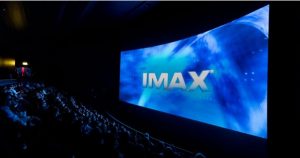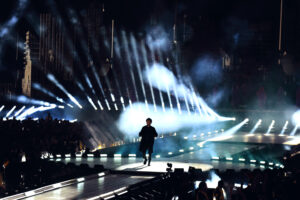Two things happened concurrently during the fourth quarter of 2022. The first was a dearth of high-profile blockbusters in movie theaters during the typically profitable holiday corridor. This allowed Marvel’s Black Panther: Wakanda Forever to stay in the Top Five longer than most prognosticators expected. It made the conditions for Avatar: The Way of Water even more favorable than they already were. But then there were the dull, wet thuds of Disney’s winter animation bid, Strange World and Paramount’s seemingly cocaine-fueled Babylon from Damian Chazelle (Whiplash, La-La Land). Beyond these, it was hardly a crush of content in movie theaters. The ramifications of studios getting cold feet are now being felt by theater chains like Cineworld which has announced bankruptcy measures and closure of many Regal Theater locations.
The second thing that happened was the crush of fans trying to obtain concert tickets for Taylor Swift’s latest tour, experiencing extremely high prices, and suffering the manic traps between the Ticketmaster-LiveNation monopoly. Point of fact, it is not solely because of Taylor Swift, but rather a change in where music’s profit center is.
In the 1960s and 1970s, the money in music was made in record sales. Radio airplay and concerts promoted records. In our modern age, record sales is the least important metric in the chain of success. Radio is pretty much over for new music discovery. Music videos are more a means to an end than a promotional tool, being a backdoor way of streaming songs without using Spotify. (This may explain why so many modern videos are lyrics-text-based.) Concerts make money, and concert merch makes more money. A used to sell B, and now B sells A.
But once upon a time, there was a thriving subgenre in movie theaters for concert films. Let’s be clear about this, though. We’re not talking about documentaries about musicians with concert footage interspersed throughout. We’re not talking about movie musicals with scenes approximating concerts. This is about multi-camera representations of concert presentations. These thrived – again in the ’60s and ’70s – but they weren’t necessarily blockbusters. Of note here is Woodstock, among others. These often filled the theater aisles during “Midnight Movie” showings when music fans…let’s say “augmented” the experience with some chemical stimulation.
 The movement died effectively in the early 1980s with the rise of MTV. Why would you go pay movie theater prices when you can see music on TV at home for “free”? And then, said concerts found a home on MTV as well, along with expensive pay-per-view events. It no longer made business sense to try to put butts in cinema seats with these.
The movement died effectively in the early 1980s with the rise of MTV. Why would you go pay movie theater prices when you can see music on TV at home for “free”? And then, said concerts found a home on MTV as well, along with expensive pay-per-view events. It no longer made business sense to try to put butts in cinema seats with these.
But here we are. Why is now the right time for the concert movie revival?
The Technology Makes It Better
It is impossible to duplicate the feeling of going to a live show, especially one where tickets are highly coveted. There are no bragging rights in going to the movie theater, and as concerts continue to be more in line experientially with going on a travel vacation or a cruise, the personal dopamine rush simply isn’t there.
However, in most cases, a live concert is not the most ideal way to experience music. It is similar to the Super Bowl phenomenon. Few could argue that you see more of the game on television, you’re closest to the action, and you hear all the field-level sound. But the cache of saying, “I went to the Super Bowl” simply is not there.
 We live in a new world of theatrical presentation, and a concert film revival should take advantage of all of these to offer a different, but worthwhile viewing event. Theaters with Dolby Atmos sound can not only offer a greater level of clarity, but discreet audio channels can provide a more immersive sound field, certainly better than many seats in auditoriums. IMAX screens deliver an enveloping visual space that can fill both the line of sight and peripheral views. The next wave of 3D technology, as demonstrated with the now $2 billion-earning Avatar sequel, can make one feel like they’re in the performance space. The dreaded high-frame rate (HFR) which delivers more visual information than the 24-fps standard is the bane of filmgoers as it makes movies look more like video (which it is, being digitally projected as nearly all theatrical showings are now), but would be a perfect application for something like a concert.
We live in a new world of theatrical presentation, and a concert film revival should take advantage of all of these to offer a different, but worthwhile viewing event. Theaters with Dolby Atmos sound can not only offer a greater level of clarity, but discreet audio channels can provide a more immersive sound field, certainly better than many seats in auditoriums. IMAX screens deliver an enveloping visual space that can fill both the line of sight and peripheral views. The next wave of 3D technology, as demonstrated with the now $2 billion-earning Avatar sequel, can make one feel like they’re in the performance space. The dreaded high-frame rate (HFR) which delivers more visual information than the 24-fps standard is the bane of filmgoers as it makes movies look more like video (which it is, being digitally projected as nearly all theatrical showings are now), but would be a perfect application for something like a concert.
In other words, technology has grown to a level where it can elevate these productions to memorable experiences, and not merely a filmed, somewhat static representation documenting an event.
2023 has been, so far, surprisingly active in movie theaters, from holdovers like Wakanda Forever and Avatar 2, to the current interest in M3GAN, to the forthcoming Ant Man and The Wasp: Quantumania. But you cannot keep that pace up and there will eventually be lulls. These may only be for one week, and then exhibitors will need those screens back. How better to fill those gaps with new content than to show a concert film with high interest? And how better to reinforce that sense of specialness than to limit the engagement to one week? Of course, it will eventually go to streaming services, but if you make the theatrical window a premium event, you are increasing the value of seeing it there as opposed to the flatscreens of home.
Three years of pent-up demand post-Covid has engineered a consumer base ready and willing to go to the show, but are they able?
I would attend more concerts personally if I could afford them. With prices as they are and not likely to come down (value is not about intrinsic worth, it’s about how much one will pay for it), it is to me as out of reach as an international vacation. I suspect that it is the same for many out there who used to enjoy two or three shows every year and now can’t even fathom one.
But I would certainly attend theatrical concert runs if they were available and beefed up, as previously described. I cannot be alone in this. That would represent a vertical that could benefit movie theaters, artists who make their major profits off of performances instead of recordings, and the eventual beneficiaries of this content, streaming services. Seems like a decent value proposition on paper.
Who gets the treatment? While recording a concert for theatrical distribution is cheaper than creating a narrative production, it’s not without cost. Therefore, the companies who do such a thing will be most inclined to open the door for acts they have high certainty will pull people in. Taylor Swift, certainly, but also Billie Eilish, The Weeknd, and Beyonce are obvious candidates.
Classic rock acts? Perhaps not so much. There’s probably a case for a simulcast of one of Billy Joel’s Madison Square Garden shows, but you are tapping into a smaller subset of attendees, many who favor the privilege of being there for real than for the show itself.
And then there are the older acts where – let’s be honest – there’s almost a morbid curiosity about seeing them perform. It’s no longer a musician I want to see before I die, it’s one I want to see before they die.
But still, if you connect the right artists with the right opportunities, this could be a gold rush for two industries to better serve each other, and could give audiences a chance at an experience which right now is out of their reach and price range.









Comments